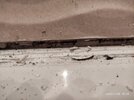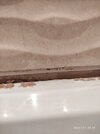I'm replacing the sealant in my Dad's bathroom, partly because he didn't do a very neat job (he refitted the entire bathroom himself and did a nice job with most of it, it's just the sealant he's not great at) and partly because there's a fair bit of mould on it now. I'm pretty sure he used an anti-mould sealant but I've bought some Tec BT1 with "unique Tribrid technology" which promises "No more mould and fungal growth" (we'll see!)
When I pulled some of the old sealant out (it's very satisfying when I manage to rip a big strip out in one piece!), I was shocked to see the back of it was almost entirely black, as you can see in the attached photo.
The bathroom has an exterior wall, which is solid brick so no cavity insulation. I'm wondering if this is just something that is going to happen until such time as we get external cladding fitted to insulate the wall?
I've attached a second photo which shows the gap between the tile and the bath where the sealant was. It's quite deep, so might it be possible to just put a thin layer of sealant there to seal the gap between the tile and the bath to stop water getting in, but without filling the depth so the sealant isn't touching the wall, and would that prevent it getting mouldy? Or is there something I could line the gap with before filling it with sealant that would isolate it from the wall and prevent it getting mouldy?
There's a plastic strip fitted to the bath so the sealant actually goes between that and the tile rather than the bath itself, then there's some more sealant under and next to the plastic strip joining it to the bath and it's quite difficult to get all the old sealant and mould out from under that. Is there a reason for using this plastic strip, rather than just having sealant filling the gap between the tile and the bath as I have in my bathroom?
It would certainly be a lot easier to replace all the sealant if that plastic strip wasn't there. Maybe it helps to avoid scratching the bath when removing the sealant between the strip and the tile, because if you slip you'll probably hit the strip rather than the bath, but if you need to replace the sealant joining the strip to the bath because that's also gone mouldy you're more likely to scratch the bath with how difficult it is to get under it, so it seems a bit pointless.
EDIT: Forget to mention I also bought some Unibond Silicone Sealant Remover. I haven't tried it yet, as it says to remove as much as possible manually so I've been doing that and I'm not sure if I need to use something to attack the remaining mould before I use this.
When I pulled some of the old sealant out (it's very satisfying when I manage to rip a big strip out in one piece!), I was shocked to see the back of it was almost entirely black, as you can see in the attached photo.
The bathroom has an exterior wall, which is solid brick so no cavity insulation. I'm wondering if this is just something that is going to happen until such time as we get external cladding fitted to insulate the wall?
I've attached a second photo which shows the gap between the tile and the bath where the sealant was. It's quite deep, so might it be possible to just put a thin layer of sealant there to seal the gap between the tile and the bath to stop water getting in, but without filling the depth so the sealant isn't touching the wall, and would that prevent it getting mouldy? Or is there something I could line the gap with before filling it with sealant that would isolate it from the wall and prevent it getting mouldy?
There's a plastic strip fitted to the bath so the sealant actually goes between that and the tile rather than the bath itself, then there's some more sealant under and next to the plastic strip joining it to the bath and it's quite difficult to get all the old sealant and mould out from under that. Is there a reason for using this plastic strip, rather than just having sealant filling the gap between the tile and the bath as I have in my bathroom?
It would certainly be a lot easier to replace all the sealant if that plastic strip wasn't there. Maybe it helps to avoid scratching the bath when removing the sealant between the strip and the tile, because if you slip you'll probably hit the strip rather than the bath, but if you need to replace the sealant joining the strip to the bath because that's also gone mouldy you're more likely to scratch the bath with how difficult it is to get under it, so it seems a bit pointless.
EDIT: Forget to mention I also bought some Unibond Silicone Sealant Remover. I haven't tried it yet, as it says to remove as much as possible manually so I've been doing that and I'm not sure if I need to use something to attack the remaining mould before I use this.




